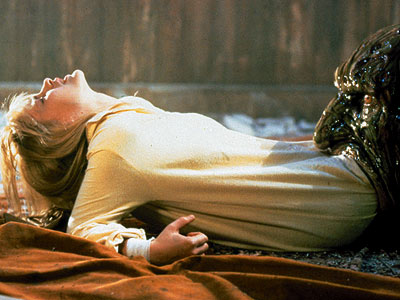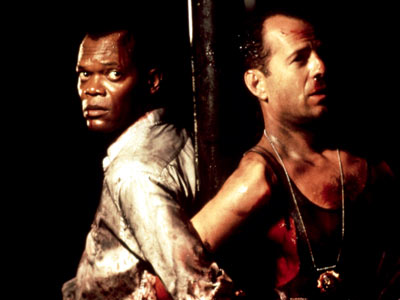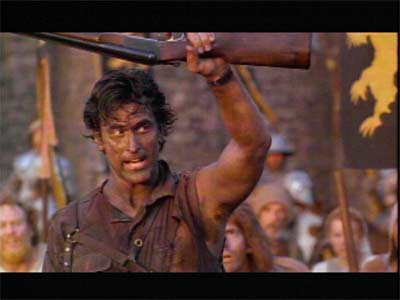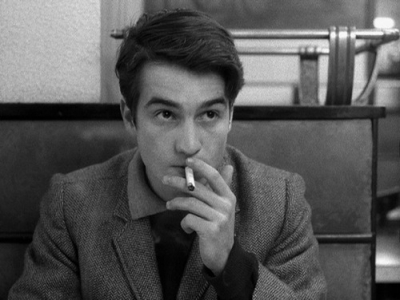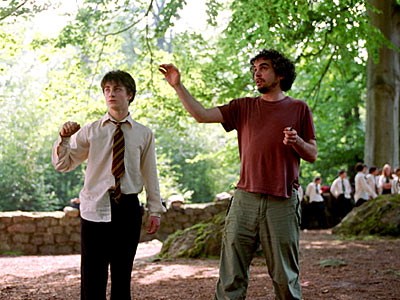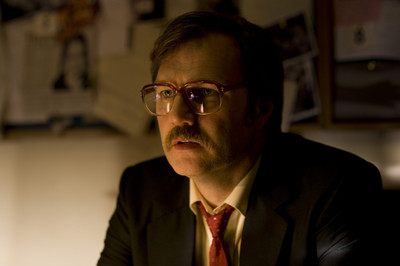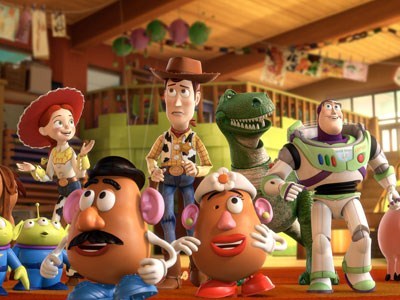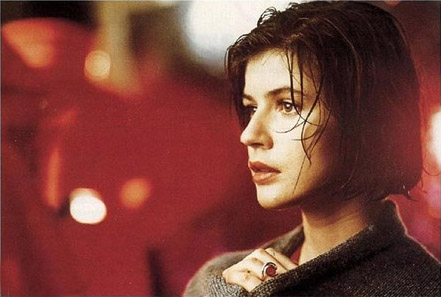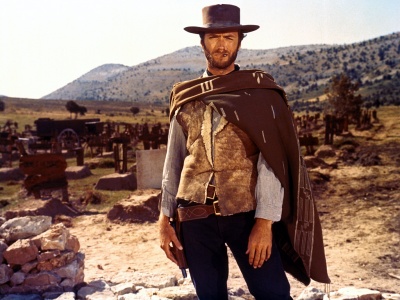The 20 Best Film Threequels
If the popular educational program Schoolhouse Rock taught us nothing else, it’s that three is a magic number. Certainly in storytelling, every plot must drive through three different points—the beginning, the middle and the end. And any comedy would be wise to adhere to the “rule of threes.” In this way, the number three becomes a powerful force indeed.
This fascination with three has made the concept of the trilogy a popular trope, particularly in film. But if coming up with a good idea for one follow-up is hard enough, executing a second follow-up at times feels like a fool’s errand.
This month alone, three threequels—ranging from massive blockbusters to an intimate indie film—will make their way into theaters: Iron Man 3, The Hangover Part III and Before Midnight (two of which make this list—we’ll let you guess which two). In celebration of this unique opportunity, this list will shine a light on some of the greatest examples of the movie threequel.
20. Back to the Future Part III
Directed by: Robert Zemeckis
Written by: Bob Gale
After the madcap mania that was Back to the Future Part II, Back to the Future Part III was criticized for restricting itself to a single time period. Or, more accurately, for being an indulgent entry driven purely by its filmmakers’ childhood desire to make a Western. And while most fans of the series will agree that this go-around stands as the weakest of the three, director Robert Zemeckis’ and producer Steven Spielberg’s love for the Western and its various tropes are so ostensibly on display here that it’s hard not to enjoy.
And, come on, what better way to cap off this legendary trilogy than with a flying, time-traveling locomotive?
19. A Nightmare on Elm Street 3: Dream Warriors
Directed by: Chuck Russell
Written by: Wes Craven, Frank Darabont, Chuck Russell, Bruce Wagner
Wes Craven’s original Nightmare on Elm Street has more than earned its place in the horror movie pantheon. Yet, anyone who has watched beyond that first installment knows that Nightmare on Elm Street: Dream Warriors stands as the superior film. As terrifying as the original can be at times, its effect is often blunted by wooden acting and dated special effects. Dream Warriors’s FX effects may not transcend its ‘80s limitations nor are its actors of Shakespearean quality (though we do see future Emmy-winner Patricia Arquette in her debut film performance), however, the film does strike the perfect balance between the franchise’s slasher horror origins and its fantasy/adventure undertones.
Wes Craven and co-screenwriter Bruce Wagner wrote this sequel to be the end of the series and—though the ending strongly hints that boogieman Freddy Krueger is not yet gone—it still manages to capture an epic sense of finality. Production was no doubt helped from re-writes by future The Shawshank Redemption filmmaker Frank Darabont as well as director/co-screenwriter Chuck Russell, who would go on to make the thoroughly entertaining 1988 remake of The Blob as well as 1995’s The Mask. The major problem with the film? Its success led to the development of three more episodes, each one increasingly more unwatchable.
18. Die Hard with a Vengeance
Directed by: John McTiernan
Written by: Jonathan Hensleigh
If pressed to name the flat-out most perfect action film of all time, Die Hard would no doubt be on the tip of many cinema-lovers’ tongues. The Renny Harlin-directed Die Hard 2: Die Harder, on the other hand, often felt like rehash of the original, with an abundance of overly goofy moments (including this one) overshadowing its sporadic moments of glory . Released five years after Die Harder, Die Hard with a Vengeance wrangled back original director John McTiernan and even managed to secure a role for Samuel L. Jackson, whose career had exploded the previous year with his Oscar-nominated performance in Pulp Fiction.
The film actually began life as a spec script called Simon Says. That script reportedly centered on a cop forced to perform various feats in order to prevent the detonation of several hidden bombs. By plugging series hero John McClane into this plotline, the film recaptures the desperate, race-against-time feel that the original displayed in spades. Moreover, whereas the previous two films restricted themselves to single locations (a corporate building and airport, respectively), Vengeance expanded the scope to cover an entire city. What’s more, the filmmakers actually shot the film on location in New York, making the action scenes feel completely tangible and grounded. Though the film loses steam in the latter third portion, it remains the closest to a truly great Die Hard sequel we’re ever going to get.
17. Iron Man 3
Directed by: Shane Black
Written by: Shane Black, Drew Pearce
A bit premature, I know. And perhaps Iron Man 3’s inclusion on the list stems simply from the irresistible spell that its spectacular action set pieces casts on its viewers. It’s a funny, fun and—yes—occasionally intelligent summer film that understands our primal reasons for wanting to go to the movies. In a world where Hollywood’s tentpole projects can feel calculated within an inch of their life, it’s refreshing to see a multimillion dollar movie that refuses to take itself too seriously and even pokes holes in its own logic. It’s a more-than-worthy follow-up to The Avengers and further cements Marvel as the go-to studio for the thinking man’s blockbusters.
16. Army of Darkness
Directed by: Sam Raimi
Written by: Ivan Raimi, Sam Raimi
Watching the original Evil Dead films back-to-back is an interesting experience, to say the least. Experiencing the series evolve from the bloody, campy horror of the original to the slasher-film-meets-Three Stooges vibe of the second to the full-blown tongue-in-check action fest that is Army of Darkness is to witness director Sam Raimi’s sensibilities become more and more unhinged. And, oh, what a delight that is.
The plot finds series hero Ash Williams transported back to medieval times following the events of Evil Dead 2. There, his experiences fighting the Deadites lends him a Messianic status among the natives. From there, Raimi throws in everything but the kitchen sink, from medieval sword-and-sandal imagery to Ash (literally) battling himself to an army of moving skeletons that would make Harryhausen proud.
Hail to the King, baby.
15. Stolen Kisses/Bed and Board
Directed by: François Truffaut
Written by: Claude de Givray, Bernard Revon, François Truffaut
Whether Stolen Kisses or Bed and Board marks the third film in François Truffaut’s semi-autobiographical Antoine Doinel series depends entirely on whether your consider the 1962 short film Antoine and Colette, in which Antoine gets routinely friend-zoned by his teenage crush, to be an entry by itself. In either case, both are absolute delights that mine the interior drama and melancholy comedy that made 400 Blows such a masterpiece. 1968’s Stolen Kisses focuses on Antoine’s attempts to readjust to regular life following a discharge from the French military, which—Antoine being Antoine—means pursuing ill-advised relationships with both a beautiful young woman and the wife of his new boss. Released two years later, Bed and Board concerns a married Antoine who finds himself contemplating an affair with a beautiful Japanese woman. Though, I have a more partial leaning towards Kisses, both films are required viewing for any one even remotely familiar with Truffaut’s filmography.
14. Harry Potter and the Prisoner of Azkaban
Directed by: Alfonso Cuarón
Written by: Steve Kloves
Having directed the first two entries in the Harry Potter film series, Home Alone director Chris Columbus often serves as the series’ whipping boy. Frequently, fans and critics alike will point out Columbus’ kid-gloves approach to adapting the source materiel, including slavishly adhering to every period and comma (flaws and all). And while some of this criticism is warranted, one has to credit Columbus with helping to establish a beautifully constructed world that subsequent filmmakers could build upon. And who better to take Columbus’ vision and give it an energizing shot of adulthood than Mexican auteur Alfonso Cuarón? Surely the fact that the Warner Bros. brass decided to task Cuarón—whose previously film, Y Tu Mamá También, centered on two childhood friend’s sexually explicit road trip with a seductive married woman—to carry on their franchise is proof that there’s still people in the industry with some serious cajones.
Granted, Cuarón doesn’t completely abduct the proceedings. The film remains a fun, studio-produced fantasy film through and through. Yet, Cuarón’s touches are definitely noticeable, with the cinematography boasting a much darker visual spectrum than Columbus’ brightly colored vision and nightmare-inducing creatures like the soul-sucking Dementors pushing the film to the limits of its PG rating. While the Harry Potter series would have great subsequent films, perhaps no other film demonstrated such a rapid a rise in quality than Azkaban.
13. Goldfinger
Directed by: Guy Hamilton
Written by: Richard Maibaum, Paul Dehn
Confession time—I’ve never been a particularly big fan of the Bond franchise. While I completely understand their appeal, they frequently come across to me as slowly paced, hokey relics of a different era with frighteningly misogynistic overtones. Recent entries Casino Royale and Skyfall, however, have led me to reevaluate my viewpoint. .And while I would still not consider myself a fan, I’ve learned to appreciate several of the more “classical” Bond films (most notably, From Russia With Love and On Her Majesty’s Secret Service).
Yet, back in the day, whenever someone would ask for my favorite Bond movie, in order to avoid having to explain myself, I would instantly spit out Goldfinger. Why? Because I, like countless actual Bond fans, saw the 1964 film as the pinnacle of the Bond series. All of the elements that people love in Bond movies are here—the intrigue, the cool action, a kickass theme song, beautiful women with cringe-worthy puns for names, a memorable villain and Sean Connery being his suave self.
12. Paradise Lost 3: Purgatory
Directed by: Joe Berlinger, Bruce Sinofsky
Sequels to documentary films are a rare thing. When a filmmaker decides to revisit a subject, however, it’s because he or she feels there are still new stories and developments that must be documented. Back in 1994, a trio of juvenile delinquents—later collectively known as the West Memphis Three—were tried and convicted for the murder of three eight-year old boys. The boys’ abrupt imprisonment caught the attention of several groups who proceeded to point out the police’s shoddy, unorganized and generally unprofessional investigation.
Among those drawn to the story were documentary filmmakers Joe Berlinger and Bruce Sinofsky. The two released the first film on the subject in 1996, followed by a sequel in 2000. Besides the drama surrounding the case, the series garnered press for being the first film allowed to use licensed music by Metallica (the duo would later direct the infamous Metallica documentary Some Kind of Monster). In 2011, the filmmakers were set to release a third installment, exploring how DNA testing would help to make a major step towards freeing the trio. Then, in a major twist, the boys stumbled upon a plea deal that would allow them to walk free. Thus, Berlinger and Sinofsky had their ending and a long, turbulent black spot in the America court system was one step closer to being rectified.
11. Mission: Impossible III
Directed by: J.J. Abrams
Written by: J.J. Abrams, Alex Kurtzman, Roberto Orci
Mission: Impossible is that rare (some would say, one-of-a-kind) film franchise where the latter installments improve upon the ones that came before. All the more fascinating is how each film so thoroughly reflects the sensibilities of the filmmaker behind the camera. Brian De Palma’s original is a sleek, labyrinth-like thriller while the (albeit, heavily compromised and re-edited) John Woo-directed sequel boasts the director’s trademark predilection for slow-mo action sequences and inexplicable use of fluttering white doves as a means of conveying dramatic moments.
Today, as De Palma’s film grows more and more dated and Woo’s entry remains a disastrous, studio-concocted mess, it’s J.J. Abrams’ Mission: Impossible III that stands as perhaps the most action-packed and intensely emotional of the series. Most noted at the time for his television work, including directing and co-writing the groundbreaking pilots for Alias and Lost, Mission: Impossible III would act as Abrams’ feature film directorial debut. Here, audiences witnessed the birth of one of my America’s finest new filmmakers—a man for whom hitting good character beats and constructing elaborate action set pieces brought about an equal level of fervor.
If you need proof, one need only watch the film’s opening scene, which still stands as one of the most gripping in Abrams’ extensive career.
This month alone, three threequels—ranging from massive blockbusters to an intimate indie film—will make their way into theaters: Iron Man 3, The Hangover Part III and Before Midnight. In celebration of this unique opportunity, this list will shine a light on some of the greatest examples of the movie threequel.
10. Red Riding: In the Year of Our Lord 1983
Directed by: Anand Tucker
Written by: Tony Grisoni
Including the Red Riding trilogy is a bit of a cheat considering that the films were not released theatrically but rather aired on Britain’s Channel 4. Yet, these three films—each starring a different cast of characters, set in a different time period, directed by different filmmakers and shot on different film stocks—represent a major achievement in modern-day filmmaking. I dare say—to put it in television terms—it’s perhaps the closest that British TV has come to creating their own version of The Wire.
Besides a few characters who overlap heavily between films, the strand connecting the entries is a series of brutal murders that take place in a West Yorkshire town. With each new film, the web of lies and cover-ups that snake their way throughout the halls of power becomes more and more pronounced. Needless to say, the films are not easy viewing (or easy listening for that matter, with many scenes necessitating the subtitle button for non-British viewers). While the first two films examine the cyclical failure of justice, Red Riding 1983—the final entry— explores the concept of redemption. Without giving anything away, the series ends on graceful note of hope, indicating that—no matter how brutal and corrupted things can get—there will always be good people trying to do the right thing.
9. Bourne Ultimatum
Directed by: Paul Greengrass
Written by: Scott Z. Burns, Tony Gilroy, George Nolfi
That Bourne Ultimatum turned out as great as it did is nothing short of a miracle given the film’s nightmarish production. Though The Bourne Supremacy proved to be a phenomenal international success both critically and commercially, the production left a deep rift between director Paul Greengrass and screenwriter Tony Gilroy. Reportedly, Gilroy was set to leave the Bourne franchise for good, until Greengrass was unable to deliver a script for the third film on time, leading the studios to pay Gilroy a sizable sum to turn in a draft. The result, according to a GQ interview with Damon in 2012, was an unreadable mess. To add to the drama, Greengrass’ tendency for approaching his films with a more improvisational, guerrilla-style mentality meant that several sequences were filmed on the fly without the support of a locked script.
In a turn of events that confirms the age-old adage that a film is made twice—once on set and once in the editing room—editor Christopher Rouse managed to shuffle through the mess and put together what became a phenomenal coda to the saga of Jason Bourne. The industry, for its part, seemed to recognize Rouse’s work, awarding him that year’s Academy Award for Best Editing along with trophies for the crew behind the film’s sound mixing and sound editing process.
8. Toy Story 3
Directed by: Lee Unkrich
Written by: Michael Arndt, John Lasseter, Andrew Stanton, Lee Unkrich
Towards the conclusion of 1999’s Toy Story 2, villain Stinky Pete asks Woody the Cowboy what he’ll do when Andy, their owner, grows up and no longer wants his toys. At the time, Woody did not have a definite answer for the duplicitous prospector. And the Pixar team could have left it there—ending on a an optimistic image of the toys mutually agreeing that they can’t stop Andy from growing, but they can enjoy the time they have left. Instead, 11 years later, John Lasseter and Co. actually made an entire movie exploring that exact question. Boasting both gut-busting laughs (Mr. Potato Head as a flour tortilla) and questionably intense drama (the toys being lowered into a fiery pit of death), this third Toy Story adventure was treated as an unequivocal success.
Story-wise, the film is not horribly original, taking its escape plotline almost beat for beat from the second film. Yet, for any audience member who had grown up with Woody, Buzz and the gang, it was all about those last five minutes—when a college-bound Andy plays with his childhood toys for the last time. It’s the film that would make you believe a jaded teenager could cry.
7. Return of the Jedi
Directed by: Richard Marquand
Written by: Lawrence Kasdan, George Lucas
Let’s get this out of the way—yes, the Ewoks are kind of silly. Excluding those cuddly marketing tools, however, Return of the Jedi has so much more to offer than simply the image of Carrie Fisher in a steel, gold bikini. Director Richard Marquand (the only non-American Star Wars director to date) fills the two-plus hour conclusion (or so we thought) to the Star Wars trilogy with countless memorable action sequences, whether it’s Luke’s fight with the Rancor, the battle to escape Jaba’s palace or the speeder bike chase through the forest moon of Endor. It all boils down, however, to the final confrontation between Luke, Darth Vadar and Emperor Palpatine (played with slimy grace by the incredible Ian McDiarmid). The sequence quietly simmers until it reaches an emotional crescendo where supervillain Darth Vadar finally remembers his humanity. Furthermore, the scene where Luke manages to finally look his father in the eyes for the first (and last) time remains one of the most powerful in the trilogy’s history.
While critical fans may yammer about the ease in which the Republic is defeated by the Ewoks or bemoan the fact that no notable characters (presumably, Han) died, one has to keep things in perspective. In an age where threequels have given us the likes of Superman 3, Spider-Man 3 and , I will gladly take a happy ending and Ewoks over this.
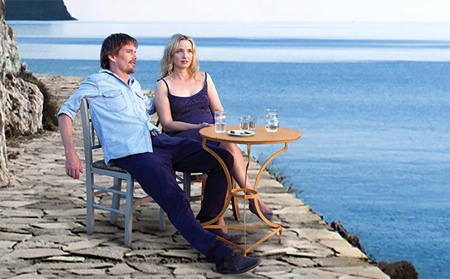
6. Before Midnight
Directed by: Richard Linklater
Written by: Richard Linklater, Julie Delpy, Ethan Hawke
Before Midnight concludes one of cinema’s great trilogies—assuming it stays a trilogy. Nine years from now, director Richard Linklater and stars Julie Delpy and Ethan Hawke could well revisit their characters from 1995’s Before Sunrise. But as it stands, they have built a beautiful study of life and love, each chapter of which stands on its own while adding emotional resonance to the other two.
2004’s Before Sunset saw Jesse and Celine re-connect in Paris for the first time since their magical night in Vienna, searching again for that rare, deep connection between two humans. Before Midnight spends another day with the characters, this time in Greece, but things are a little different. While they are still extremely connected to one another, additional people also command their attention and somewhat limit their personal time together.
Which doesn’t mean the two leads don’t converse. The series’ trademark intense, thoughtful and personal conversations remain. An early scene holds on one perfectly acted two-shot in a car for 13 minutes. The discussions are often as hilarious as they are engaging. Hangups, regrets and doubts have have become a greater part of Jesse and Celine’s lives, and the film reflects that. But it also reminds us what made the couple such a lovable pair that they could hold our interest for 20 years.—Jeremy Mathews
5. Three Colors: Red
Directed by: Krzysztof Kie?lowski
Written by: Krzysztof Kie?lowski, Krzysztof Piesiewicz
Red would turn out to be Krzysztof Kie?lowski’s final film. Whether the Polish director knew he was near death’s door while he was filming the final portion of his Three Colors trilogy is not known. In any case, it’s hard to picture a better final film to bow out with.
The idea surrounding Kie?lowski’s Three Colors was to make three films, each based around one of the three political ideals represented in the French flag: blue (liberty), white (equality) and red (fraternity). Often, the films would be structured as a means of undermining the very notion that the colors represent, with characters from different films making a random, happenstance occurrence in each other’s stories. Red is often dubbed the “anti-romance” segment of the trilogy and for good reason. The film centers on the relationship between a naïve young model and a reclusive middle-aged man who spends his day listening in to his neighbor’s telephone conversations. Simultaneously, we follow the story of a young law student who comes to believe his girlfriend is cheating on him. Hardly the passionate romantic romp that the title implies. That’s not to say the film is hard to watch. On the contrary, it’s simply mesmerizing. Like Kie?lowski’s best work—The Double Life of Veronique or The Decalogue—the beauty of the story comes not necessarily in what happens but how Kie?lowski deftly structures the execution. And while watching the previous entries in the trilogy, Blue and White, are not necessary to understanding Red, having viewed the two gives the film’s final minutes a powerful kicker.
4. Indiana Jones and the Last Crusade
Directed by: Steven Spielberg
Written by: Jeffrey Boam, George Lucas, Menno Meyjes, Tom Stoppard (uncredited)
After the mindfreak that was Indiana Jones and the Temple Doom left a (literal and figurative) bad taste in audiences’ mouths (creating the PG-13 rating in the process), Steven Spielberg and his collaborators went back to the drawing board, crafting a film that would retain the simpler tone of Raiders of the Lost Ark without feeling like a rehash of that Oscar-nominated adventure. After filing through several different pitches and drafts (Spielberg even admitted at one point he felt he was “too old” for some of the stories), Spielberg and producer/writer George Lucas settled on a story about the search for The Holy Grail.
Spielberg’s stroke of genius, however, was not only his decision to incorporate Indiana’s Jones estranged father into the plotline but to cast Sean Connery to fill the role. The dramatic dynamic between father and son lends the film an emotional heft that is noticeably absent from the more lightweight Raiders. In this way, one could perhaps even hold up Last Crusade as the superior story (emphasis on “perhaps”). Plus, as an added bonus, the film offers a prologue featuring the late, great River Phoenix as a young Indiana Jones. That right there is a major point in the film’s favor.
3. The Lord of the Rings: The Return of the King
Directed by: Peter Jackson
Written by: Philippa Boyens, Peter Jackson, Fran Walsh
The Return of the King’s place on the list depends entirely on whether you actually see the Rings series as an actual trilogy or merely a 13-plus-hour single movie. For the sake of simplicity, I lean towards the former. In any case, there’s little I can say about the film that its record-breaking box-office, 11 Academy Awards and legions of rapid fans have not already outlined. So, just to give you an idea of how much I regard this final entry in Peter Jackson’s film series, here’s a personal detail. In the decade since this film has been released, I have only seen it twice. Once, in the theater at the time of its release and again in the summer of 2011 when the films were re-released in theaters (presumably, to help hype audiences up for The Hobbit). The reason? I refuse to have my experience of the film be hampered by seeing it on anything less than the biggest screen available. I just like it that much.
Though a live-action adaptation of J.R.R. Tolkien’s epic trilogy was in demand for many years, fans should be forever thankful that the right people with the right tools came along at the exact right time to land the perfect execution. Considered one of the boldest, most creative filmmaker at the time, Jackson’s reputation for overly indulging in his stories has somewhat hampered his reputation as of late. Yet, Jackson will always have Rings. Here, he not only captures the epic scale of the battle sequences but also deftly handles the escalating character drama as well, with Sean Astin delivering one of the highlight performances of the whole series as the forever noble Samwise Gamgee. Never has there been a better example of “guy love.”
2. Pusher 3
Directed by: Nicholas Winding Refn
Written by: Nicholas Winding Refn
Before he made Ryan Gosling look awesome behind the wheel in Drive, before he cast future Hannibal star Mads Mikkelsen as a badass, mute Viking in Valhalla Rising, before he helped Tom Hardy go from a trim figure to a juggernaut of a man in Bronson, Danish director Nicholas Winding Refn made his presence on the world’s stage with one of the best movie trilogies of all time: the Pusher Trilogy. Set in the dirty, underground crime world of Copenhagen, each entry in the Pusher series follows a different character as they attempt to navigate the deadly minefield of their environment and avoid ending up on the wrong side of a gun.
The final installment spans a day in the life of a Serbian drug lord named Milo. Having been feared and respected by many across the first two films, Milo now finds his authority and power waning. His fall serves as an excellent illustration of the film’s crime-infested setting, where concepts like structure or order are pithy and fleeting. Refn may have moved on to more high-profile gigs, but Pusher remains a defining cornerstone of his career. It’s a trilogy as profound as it is entertaining.
1. The Good The Bad and the Ugly
Directed by: Sergio Leone
Written by: Agenore Incrocci & Furio Scarpelli, Sergio Leone, Luciano Vincenzoni
Director Sergio Leone and star Clint Eastwood hit the ground running with their first collaboration A Fistful of Dollars, which took a Western interpretation of Akira Kurosawa’s samurai film Yojimbo. Following the adventures of Eastwood’s Man With No Name, the Dollars trilogy continued on through 1965’s For a Few Dollars More and, finally, to 1966’s The Good, The Bad and The Ugly.
Often branded as Leone’s magnum opus, The Good, The Bad and The Ugly centers on three different gunslingers—Eastwood included—competing to seize control of an abandoned collection of Confederate gold. The film highlights many of the techniques that made Leone a legendary figure in the filmmaking world— from his crisp depth of field, to his expertly edited battle scenes to, of course, his use of long, lingering shots to ramp up the tension for an upcoming duel. Augmented by Ennio Morricone’s bombastically brilliant score, the film acts as a sort of quasi-opera of violence and mayhem in the Civil War-torn America.
While certain elements call the continuity of the trilogy into question (the casting of Lee Van Cleef as “The Bad” is a bit disingenuous considering he played a more noble character in For a Few Dollars More), the film remains a testament to how a threequel, with a healthy does of talent, ambition and ingenuity, can both buck the trend and make film history at the same time.
GET PASTE RIGHT IN YOUR INBOX
The best music, movies, TV, books, comedy and more.

